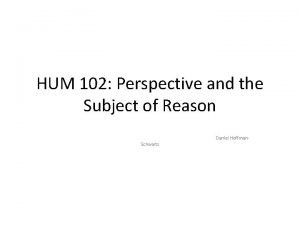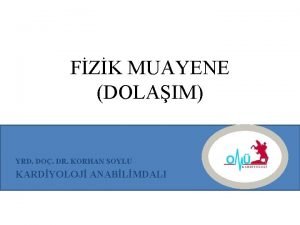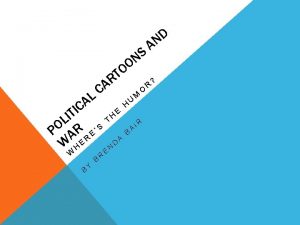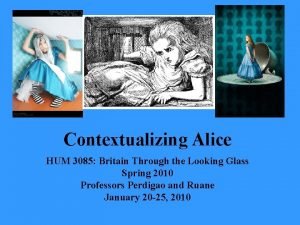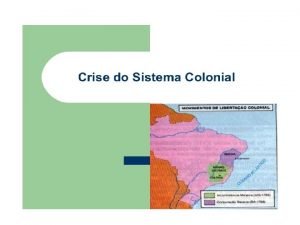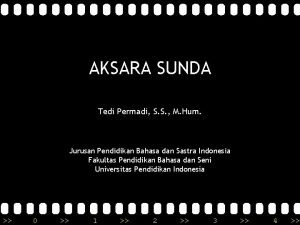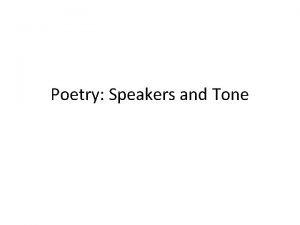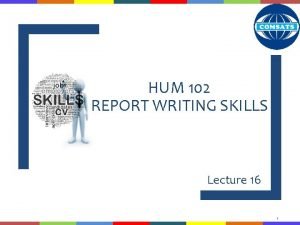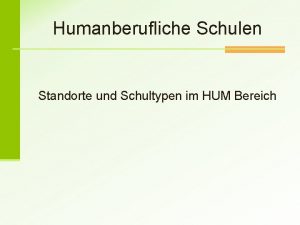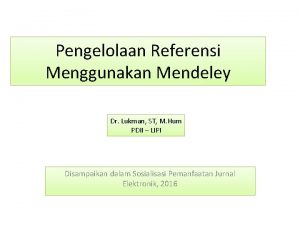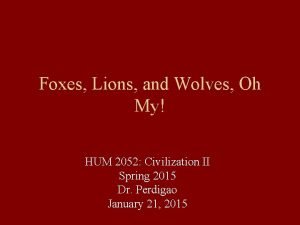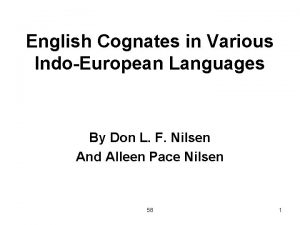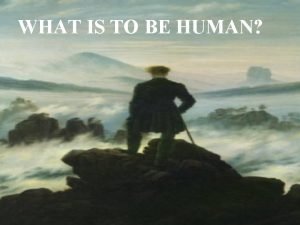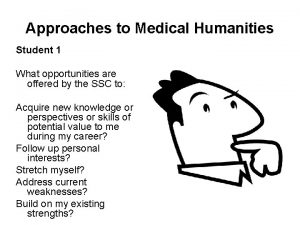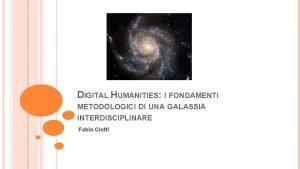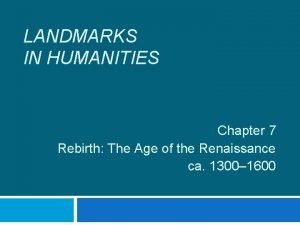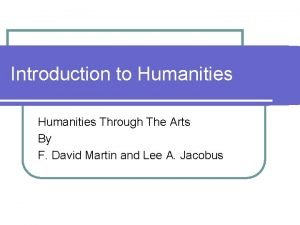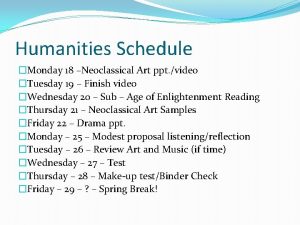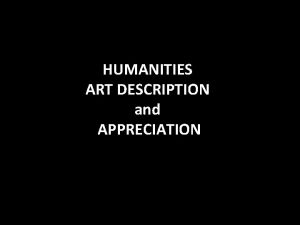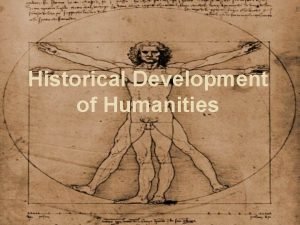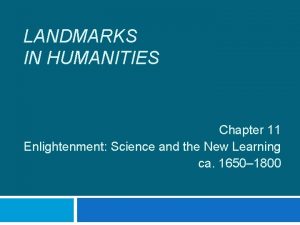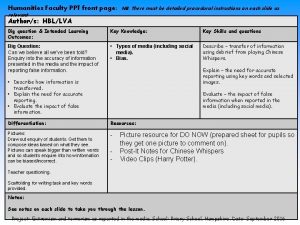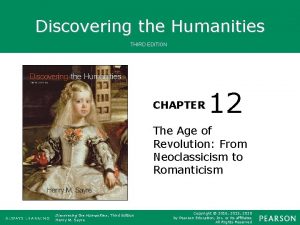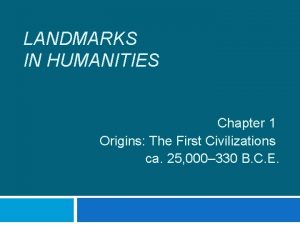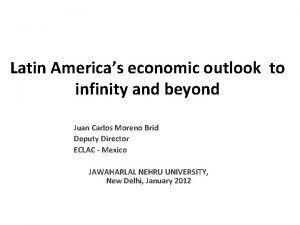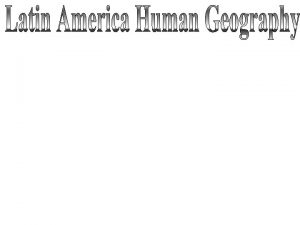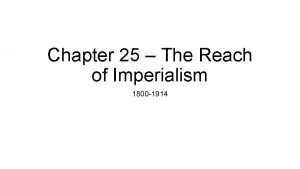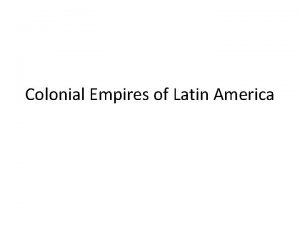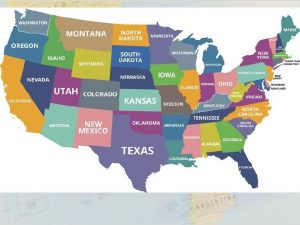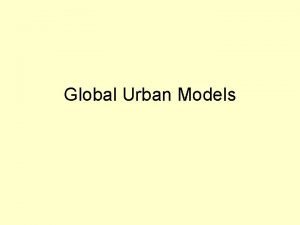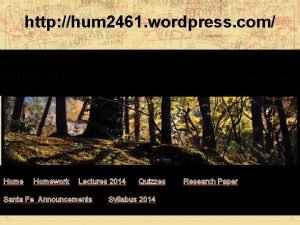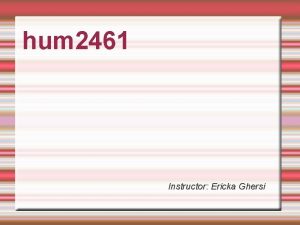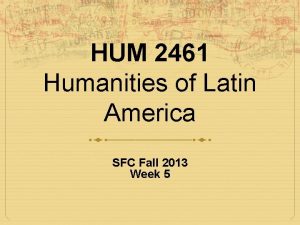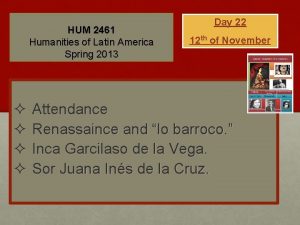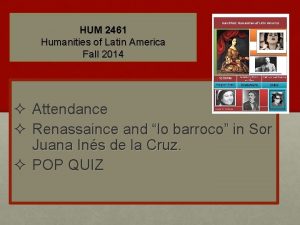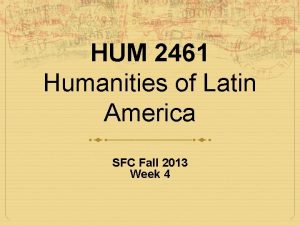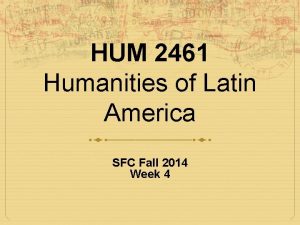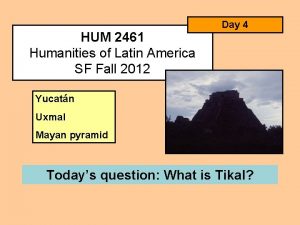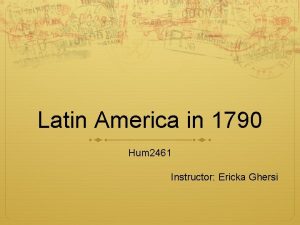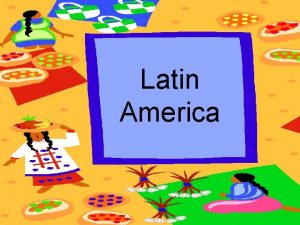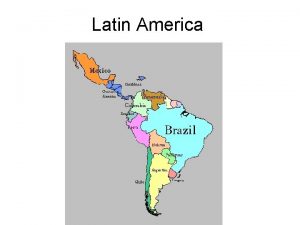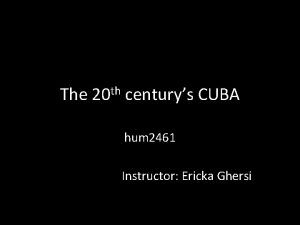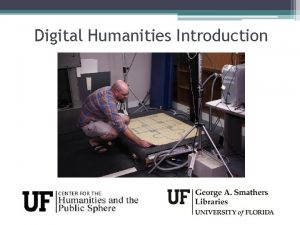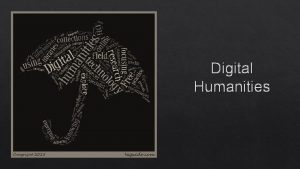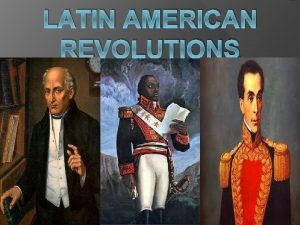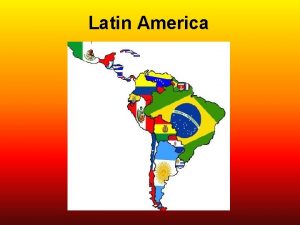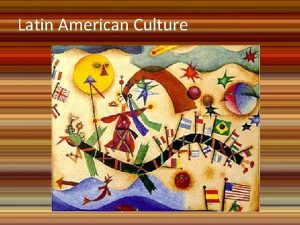HUM 2461 Humanities of Latin America Week 7





















































- Slides: 53

HUM 2461 Humanities of Latin America Week 7

Today’s Agenda Day 12 • Attendance • Inca Architecture (1150 -1541) • Medieval Spain (411 -1500): 1. Al-Andalusian/Spain 2. Architecture and Art • 2 nd Assignment is due today

Attendance

CANVAS

Inca Architecture Cultural Periods (1150 -1541) Expansion 1438 CE

Review 1200: Manco Cápac organizes the kernel of the Inca people. 1438: Expansion of Tawantinsuyo started with Inca Pachacuti

Tawantinsuyo four cardinal points Four Suyos (side/location): 1. Collasuyo (S) 2. Chinchaysuyo (N) 3. Contisuyo (SW) 4. Antisuyo (NE) Inti = sun

Inca Architecture (1) 1. It is widely known for its fine masonry, which features precisely cut and shaped stones closely fitted without mortar. 2. No internal walls and roofed with wooden beams and thatch. …Gabled roofs, rooms with one or two of the long sides opened and rooms that shared a long wall.

Precisely cut and shaped stones

A thatched Bed & Breakfast Hotel

Gabled Roofs

Storehouses qollqa: Gabled Roofs

Residential area: gabled roofs

Inca Architecture Characteristics (2) 3. Wall apertures, including doors, niches and windows, usually had a trapezoidal shape. They could be fitted with double or triple jambs as a form of ornamentation. 4. Rectangular buildings were used for quite different functions in almost all Inca buildings, from humble houses to palaces and temples.

Trapezoidal Shape

Trapezoidal Windows

Lintel and double jamb Lintel Double jamb

Inca Architecture (3) Kancha Main rectangular enclosure

Cusco City

Testimonies of this type of architecture are

Ollantaytambo (La Fortaleza/The Fortress)

Top of La Fortaleza Precisely cut and shaped stones closely fitted without mortar.

The bath of the Princess Chakana

Machu Picchu

Machu Picchu • Pachacutec (Pachacuti) built Cuzco and Machu Picchu in 1438. • Means old mountain. • Ancients work systems: 1. Minca (team work for the Ayllu) 2. Mita (community service) 3. Ayni (team work of the ayllu) 1438 - 1541: Inca culture and empire (Tawantinsuyu) MINKA

Pedro Cieza de León "For as is well known to all, not a single village of the highlands or the plains failed to pay the tribute levied on it by those who were in charge of these matters. There were even provinces where, when the natives alleged that they were unable to pay their tribute, the Inca ordered that each inhabitant should be obliged to turn in every four months a large quill full of live lice, which was the Inca's way of teaching and accustoming them to pay tribute”

Terraced structures

Agricultural sector

Intihuatana / Inti watana HUATA TO TIE UP, TO HICH & NA is a suffix for TOOL or PLACE

Mesoamerica Important Dates Maya: Classic 353 -900 CE Hasaw Chan K’awill reigned since 695 CE & Hasaw's wife, Lady Twelve Macaw, died in 704 Maya: Post-classic 900 -1523 (1697) Teotihuacanos 100 BCE – 750 CE Toltecs 900 – 1200 Aztecs 1300 – 1521 Inca Civilization 1150 -1541 1200: Manco Cápac organizes the kernel of the Inca people. Machu Picchu is built in 1450 -1480 by Pachacuti.

Medieval Spain (4111500) Al-Andalus/Spain

Al-Andalus/Spain From Moorish Architecture and Art Style to Spanish Style

Dates 1. Early Medieval Spain (ca. 411– 585) 2. Medieval Islamic Spain (ca. 710 -1492) 3. Medieval Christian Spain (ca. 1492) 4. Medieval Spanish Culture (ca. 1492 -1500) End of Medieval age in Spain (1500)

Architecture of Al-Andalus (Mudejar style) 1. Early Medieval Spain (ca. 411– 585) 2. Medieval Islamic Spain (ca. 710 -1492) 2. Medieval Christian Islamic Spain (ca. 710 -1492) 3. Spain (ca. 1492) 4. Medieval Spanish Culture (ca. 14921500) The year 1492 is commonly accepted as the beginning of the influence of the Renaissance in Spain.

Periods and styles in Art and Architecture: 1. Byzantine (circa 295 -650) 2. Pre-Romanesque (500 -1000) (Mudejar Style influence) 3. Romanesque (1000 -1200) (Mudejar style influence) 4. Gothic (1200 -1500) (Mudejar style influence)

Map of Al-Andalus (Spain) in the 10 th century How did Spain look like during these 782 years? Córdova Sevilla Granada

Santa Maria del Naranco (850 CE) • Visigothic architecture • Early medieval secular architecture • Belongs to the Kingdom of Asturias (North) • 587 CE converted to Catholicism • Maya Classic 353 -900 CE

Mudejar Style (Muslim Architecture) 710 -1492 CE Influence of the Muslim architecture can be appreciated in the center and south of Spain

Mudejar style Symbiosis of techniques and ways of understanding architecture resulting from Muslim and Christian cultures. Brick as the main material. Developed complicated tiling patterns. Dominant geometrical character. The Alcazar of Seville is considered one of the greatest surviving examples of the style.

Alcázar from Sevilla (ca. 1300)

Alcazar of Seville (inner courtyard) Interior

Map of Al-Andalus (Spain) in the 10 th century Córdova Sevilla Granada

The Great Mosque of Cordova (784 CE)

The Great Mosque of Cordova (784 CE) exterior

Alhambra, Granada (1237 CE)

Mesoamerica Important Dates Maya: Classic 353 -900 CE Hasaw Chan K’awill reigned since 695 CE & Hasaw's wife, Lady Twelve Macaw, died in 704 Maya: Post-classic 900 -1523 (1697) Teotihuacanos 100 BCE – 750 CE Toltecs 900 – 1200 Aztecs 1300 – 1521 Inca Civilization 1150 -1541 1200: Manco Cápac organizes the kernel of the Inca people. Machu Picchu is built in 1450 -1480 by Pachacuti.

Alhambra, Granada (1237 CE) interior

Alcázar from Segovia (1120 CE)

Map of Spain in the 10 th century . Segovia Córdova Sevilla Granada

Mesoamerica Important Dates Maya: Classic 353 -900 CE Hasaw Chan K’awill reigned since 695 CE & Hasaw's wife, Lady Twelve Macaw, died in 704 Maya: Post-classic 900 -1523 (1697) Teotihuacanos 100 BCE – 750 CE Toltecs 900 – 1200 Aztecs 1300 – 1521 Inca Civilization 1150 -1541 1200: Manco Cápac organizes the kernel of the Inca people. Machu Picchu is built in 1450 -1480 by Pachacuti.

Al-Andalus Spain 1. 1469: Isabel and Ferdinand married. 2. 1492: Emir Muhammad XII surrendered the Emirate of Granada to Queen Isabella I of Castile. 3. 1492: Jews are expelled from Spain. *** 4. 1492– 1507 - The remaining Muslims in the Crown of Castile were ordered to become Catholic. Santa Inquisition. 5. The cultural and social contributions under Muslim rule still persist in Al-Andalus/Spain.

nd 2 Assignment HW#4 is due today (week 7)

 Why is it called latin america
Why is it called latin america Sfc-2461
Sfc-2461 Week by week plans for documenting children's development
Week by week plans for documenting children's development Hum 102
Hum 102 Bigemine nabız nedir
Bigemine nabız nedir Humanities art appreciation
Humanities art appreciation Ho hum political cartoon meaning
Ho hum political cartoon meaning Alice hum
Alice hum Mkm.m
Mkm.m Conjuração mineira resumo
Conjuração mineira resumo Hum schulen
Hum schulen Kaligrafi aksara sunda
Kaligrafi aksara sunda My grandmother would rock quietly and hum
My grandmother would rock quietly and hum Hum 102
Hum 102 Hum schultyp
Hum schultyp Dr lukman st m hum
Dr lukman st m hum Abe hum pen thin height meaning
Abe hum pen thin height meaning Oh so hum
Oh so hum Asia africa north and south america
Asia africa north and south america Repetition in let america be america again
Repetition in let america be america again Happening e performance
Happening e performance We can do a rap of the map of the us
We can do a rap of the map of the us Pashto language words
Pashto language words What is humanities
What is humanities What is medical humanities
What is medical humanities Ihsst
Ihsst Art and humanities endorsement
Art and humanities endorsement College of humanities and social sciences
College of humanities and social sciences Digital humanities
Digital humanities What is humanities
What is humanities Where was the early renaissance (ca. 1400-1490) centered?
Where was the early renaissance (ca. 1400-1490) centered? Humanities through the arts
Humanities through the arts Humanities art appreciation ppt
Humanities art appreciation ppt Scope of humanities in art appreciation
Scope of humanities in art appreciation Describe the historical background of humanities
Describe the historical background of humanities Humanities essay
Humanities essay Landmarks in humanities
Landmarks in humanities Ldap cuni
Ldap cuni Introduction to humanities ppt
Introduction to humanities ppt Arts and humanities endorsement
Arts and humanities endorsement Local guide program
Local guide program Benjamin latrobe
Benjamin latrobe Ca humanities
Ca humanities Landmarks in humanities 5th edition chapter 1
Landmarks in humanities 5th edition chapter 1 Columbus humanities arts and technology academy
Columbus humanities arts and technology academy What are the humanities
What are the humanities To infinity and beyond latin
To infinity and beyond latin Bolivia christmas food
Bolivia christmas food Landforms of latin america
Landforms of latin america Largest economy in latin america
Largest economy in latin america Chapter 25 lesson 2 empire building in africa
Chapter 25 lesson 2 empire building in africa Colonial empires in latin america
Colonial empires in latin america Latin america physical features
Latin america physical features Latin american model
Latin american model



